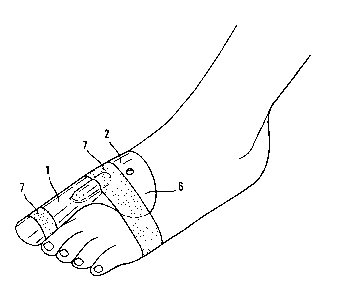Une partie des informations de ce site Web a été fournie par des sources externes. Le gouvernement du Canada n'assume aucune responsabilité concernant la précision, l'actualité ou la fiabilité des informations fournies par les sources externes. Les utilisateurs qui désirent employer cette information devraient consulter directement la source des informations. Le contenu fourni par les sources externes n'est pas assujetti aux exigences sur les langues officielles, la protection des renseignements personnels et l'accessibilité.
L'apparition de différences dans le texte et l'image des Revendications et de l'Abrégé dépend du moment auquel le document est publié. Les textes des Revendications et de l'Abrégé sont affichés :
| (12) Brevet: | (11) CA 2192127 |
|---|---|
| (54) Titre français: | ATTELLE POUR DOIGT EXTERNE |
| (54) Titre anglais: | TOE SPLINT FOR AN OUTER TOE |
| Statut: | Périmé et au-delà du délai pour l’annulation |
| (51) Classification internationale des brevets (CIB): |
|
|---|---|
| (72) Inventeurs : |
|
| (73) Titulaires : |
|
| (71) Demandeurs : |
|
| (74) Agent: | MARKS & CLERK |
| (74) Co-agent: | |
| (45) Délivré: | 2003-04-29 |
| (22) Date de dépôt: | 1996-12-05 |
| (41) Mise à la disponibilité du public: | 1998-03-19 |
| Requête d'examen: | 2000-02-07 |
| Licence disponible: | S.O. |
| Cédé au domaine public: | S.O. |
| (25) Langue des documents déposés: | Anglais |
| Traité de coopération en matière de brevets (PCT): | Non |
|---|
| (30) Données de priorité de la demande: | ||||||
|---|---|---|---|---|---|---|
|
L'invention se rapporte à une attelle pour doigt de pied, plus précisément un orteil externe, comportant une partie arrière destinée à prendre appui sur le métatarse, et une partie avant devant retenir l'orteil qui doit être supporté. La partie servant à retenir et la partie servant à soutenir sont toutes deux dotées d'un partie latérale qui doit venir en contact avec le bord externe du pied et de l'orteil. L'amélioration apportée par l'invention réside dans le fait que les parties latérales sont en continuité mécanique, comme une attelle.
The invention relates to a toe splint for an outer toe,
having a rear holding part, which is to be placed against
the metatarsus, and a supporting part, which is
integrally connected thereto and is to be placed upon the
toe to be supported. The holding part and the supporting
part each have a side portion to be placed against the
outer edge of the foot or toe. The improvement according
to the invention consists in the fact that the side
portions are continuously joined in the manner of a
splint.
Note : Les revendications sont présentées dans la langue officielle dans laquelle elles ont été soumises.
Note : Les descriptions sont présentées dans la langue officielle dans laquelle elles ont été soumises.

2024-08-01 : Dans le cadre de la transition vers les Brevets de nouvelle génération (BNG), la base de données sur les brevets canadiens (BDBC) contient désormais un Historique d'événement plus détaillé, qui reproduit le Journal des événements de notre nouvelle solution interne.
Veuillez noter que les événements débutant par « Inactive : » se réfèrent à des événements qui ne sont plus utilisés dans notre nouvelle solution interne.
Pour une meilleure compréhension de l'état de la demande ou brevet qui figure sur cette page, la rubrique Mise en garde , et les descriptions de Brevet , Historique d'événement , Taxes périodiques et Historique des paiements devraient être consultées.
| Description | Date |
|---|---|
| Le délai pour l'annulation est expiré | 2016-12-05 |
| Lettre envoyée | 2015-12-07 |
| Inactive : CIB de MCD | 2006-03-12 |
| Accordé par délivrance | 2003-04-29 |
| Inactive : Page couverture publiée | 2003-04-28 |
| Inactive : Taxe finale reçue | 2003-02-06 |
| Préoctroi | 2003-02-06 |
| Un avis d'acceptation est envoyé | 2002-09-24 |
| Un avis d'acceptation est envoyé | 2002-09-24 |
| Lettre envoyée | 2002-09-24 |
| Inactive : Approuvée aux fins d'acceptation (AFA) | 2002-09-10 |
| Modification reçue - modification volontaire | 2001-05-29 |
| Modification reçue - modification volontaire | 2000-06-27 |
| Lettre envoyée | 2000-03-28 |
| Inactive : Renseign. sur l'état - Complets dès date d'ent. journ. | 2000-03-27 |
| Inactive : Dem. traitée sur TS dès date d'ent. journal | 2000-03-27 |
| Toutes les exigences pour l'examen - jugée conforme | 2000-02-07 |
| Exigences pour une requête d'examen - jugée conforme | 2000-02-07 |
| Inactive : Page couverture publiée | 1999-09-30 |
| Demande publiée (accessible au public) | 1998-03-19 |
Il n'y a pas d'historique d'abandonnement
Le dernier paiement a été reçu le 2002-11-27
Avis : Si le paiement en totalité n'a pas été reçu au plus tard à la date indiquée, une taxe supplémentaire peut être imposée, soit une des taxes suivantes :
Veuillez vous référer à la page web des taxes sur les brevets de l'OPIC pour voir tous les montants actuels des taxes.
Les titulaires actuels et antérieures au dossier sont affichés en ordre alphabétique.
| Titulaires actuels au dossier |
|---|
| WALDEMAR LINK (GMBH & CO) |
| Titulaires antérieures au dossier |
|---|
| ROBERT D. LOCKHART |